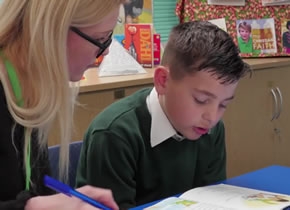
Request a full Catch Up® information brochure and details of our free information webinars
Find out more
The following question came up on Catch Up® Literacy training: What should I do if a pupil adds extra words when reading?
Do you have pupils who do that? It’s almost as if the printed words are just a hint about what should be read! These pupils often add in extra words or change the order of the words. If we can pinpoint why they are doing it, then we can help them to kick the habit.
Could it be visual stress?
One thing to check out is whether the pupil has some minor eye imbalance? Maybe they’re finding it hard to focus on the printed word on the page. Some pupils find black font on a white background creates visual stress. Try placing a coloured overlay on the page and see if this improves the accuracy of matching reading to print.
Try to identify the effect of the ‘extra’ words.
Do the additional words embellish the text but do not essentially change the meaning?
For example, the text says: She was putting on her socks.
The learner reads: She was putting her socks on her feet.
On the plus side, this is a good indication that the pupil is reading for meaning, but there are occasions where accurate reading of the words on the page is crucial for comprehension, particularly when reading non-fiction.
Alternatively, are the additional words just random and change the meaning?
For example, the text says: She was putting on her socks.
The learner reads: She was putting over here her socks.
In both cases, we need to guide the pupil to read only the printed words.
Tips for helping pupils read what is written on the page
Catch Up® is the working name of The Caxton Trust, a not-for-profit charity registered in England and Wales (1072425) and Scotland (SC047557) as well as a company limited by guarantee (03476510). Catch Up is a registered trademark.
The Catch Up® Web site use "cookies" to help you personalise your online experience. A cookie is a text file that is placed on your hard disk by a Web page server. Cookies cannot be used to run programs or deliver viruses to your computer. Cookies are uniquely assigned to you, and can only be read by a web server in the domain that issued the cookie to you.
Click on the different category headings below to find out more. You can change your default settings very easily. To turn cookies on, click the button to the right. To turn cookies off, click the buttons to the left. Please read our cookie policy to find out more.
Performance monitoring cookies: Google Analytics cookies (_ga,_gid) - these can last up to 2 years.
Strictly necessary cookies used by the site content management system: PHPSESSID (used to record your logged in session) and allow_cookies (used to record that the user has consented to cookies) - these are either temporary (session) cookies or expire after no more than 30 minutes and are used to provide functionality as you navigate around the site and allow you to access secure areas.